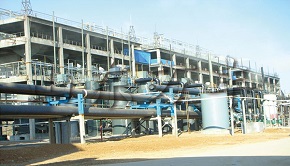 [posted on ToxicLeaks, 19 January 2017] Domestic media reported that a red-mud reservoir at Sanmenxia in Mianchi County failed at approximately half past six in the afternoon of December 15th. The reservoir, operated by East Hope Sanmenxia Aluminum Co., Ltd. reportedly flooded the area with toxic tailings, leading to the immediate death of at least two individuals. Local emergency-management officials, including representatives from the occupational safety bureau, the health department, and local law enforcement, organized a response shortly after the dam’s failure. The latest reports available indicate that such personnel are continuing the emergency response and initiating disaster-mitigation operations.
[posted on ToxicLeaks, 19 January 2017] Domestic media reported that a red-mud reservoir at Sanmenxia in Mianchi County failed at approximately half past six in the afternoon of December 15th. The reservoir, operated by East Hope Sanmenxia Aluminum Co., Ltd. reportedly flooded the area with toxic tailings, leading to the immediate death of at least two individuals. Local emergency-management officials, including representatives from the occupational safety bureau, the health department, and local law enforcement, organized a response shortly after the dam’s failure. The latest reports available indicate that such personnel are continuing the emergency response and initiating disaster-mitigation operations.
This is not the first red-mudslide to occur in the area in recent months. Another such incident occurred in early August in another location in Mianchi County, at the Henan Xiangjiang Wanji Aluminum Co., Ltd. The plant was shut down only days before due to the weakening of the dam holding in the substantial reservoir, and three hundred residents were evacuated from the area. The county government called in industry experts to inspect all four red-mud reservoirs in the area after the spill, and prompted local metals firms Sanmenxia Aluminum Co. and Yixiang Aluminum Co. as well as local municipal governments to conduct inspections of their own as well, with orders to report back with their findings. What’s more, in July 2016, the government of Mianchi Country checked East Hope’s red mud field following reports about ground water contamination. The company was exonerated shortly afterwards, after local officials found no proof for the complaint
For the massive, deadly pollution released last month by East Hope, the firm has so far not been held responsible for its gross negligence. According to Chinese law (specifically the Regulation on Reporting and Investigation and Handling of Production Safety Accidents), any accident in which there are fewer than three deaths is classified as an “ordinary” accident, and such apparently run-of-the-mill incidents go no further than the municipal government. Further, according to the ponderously titled Interim Provisions on Penalty Penalties for the Regulations on the Reporting and Investigation and Handling of Production Safety Accidents, municipal governments may fine a company whose actions lead to casualties the paltry sum of between ¥100,000 and ¥200,000 ($14,600 and $29,000), or the more substantial penalty of a fine equal to between 40% and 80% of the company’s total income the previous year. As of the last reports available, no indication that such a fine has been levied appears in notices on either Sanmenxia’s or Mianchi County’s websites.
The problem of red mud and its disposal will only become more of an issue, especially in China. Between one and one-and-a-half tons of red mud is produced per ton of aluminium when using the Bayer Process for separating aluminium from bauxite ore. The estimated global annual production of red mud in recent years is 150 million metric tons, much of which is produced by China’s thirty aluminium refineries. In addition to these active sites, China is believed to have another fifty closed sites with red mud reservoirs.
The problem is only going to get worse because of China’s continuing irresponsible growth in aluminium production. In 2000 China produced a rather paltry 2.5 million metric tons of alumina. Since then, and thanks to a shot in the arm in the form of massive subsidies from Beijing, China’s capacity has mushroomed to 59 million metric tons in 2015. The resulting production of caustic red mud has grown along with it as well, clocking in at least 90 million metric tons per year. With China’s runaway aluminium capacity continuing to balloon and its government’s indifference to the problem, more environmental degradation and more fatalities are all but certain.
